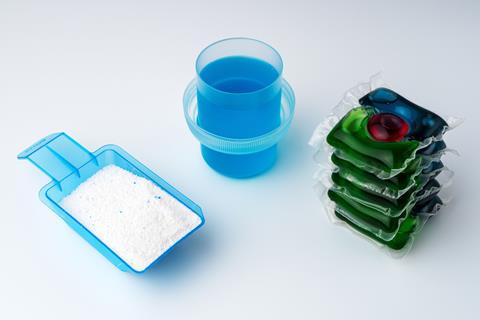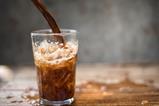Discover the chemistry of bright whites and clean coloured clothes, and the different detergents that wash them
All laundry detergents are designed to clean your clothes, so you might assume they all do this in the same way. But with a host of detergent types – such as bio, non-bio, colour-fast – coming in a vast range of powders, liquids, capsules and even strips, there’s far more chemistry going on than first meets the eye.
What’s in a detergent?

Almost all laundry detergents contain a surfactant – the ingredient that provides most of the cleaning power. People used soap as the surfactant in the first detergents. Today, manufacturers use anionic surfactants such as alkyl sulfates and non-ionic surfactants instead. These molecules have water-loving (hydrophilic) heads and long water-avoiding (hydrophobic) hydrocarbon tails. When you wash clothes, the hydrophobic tails of surfactant molecules are attracted to any oil and grease on the clothes’ surface. A group of surfactant molecules then surround the oil droplets, forming spheres with the oil trapped inside. These spheres – called micelles – lift off the clothes’ surface and get washed away down the drain.
Some laundry detergents also contain bleaching agents that release hydrogen peroxide during the wash cycle. The hydrogen peroxide oxidises stains from certain foods and from gardening, such as chlorophyll (found in grass). The oxidation breaks down the stains, making it easier to wash them away. These bleaching agents are why people used hot washes in the past: hydrogen peroxide is only an effective bleach at temperatures over 60°C. Today, we can use colder washes as laundry detergents also contain bleach activators – molecules that react with hydrogen peroxide to produce peroxy acids, which then act as the bleach on clothes.
Biological laundry detergents also include enzymes. These break down stubborn stains, such as fats and proteins, into smaller molecules in the same way they work in our bodies. While enzymes are great at cleaning clothes, they can irritate some people’s skin. Non-bio detergents don’t contain enzymes and usually avoid colourings and fragrances to make them even kinder to sensitive skin.
Laundry detergents can also contain water softeners, known as chelating agents. These react with metal ions from dissolved minerals (such as calcium and magnesium) found in hard water. In doing so, the chelating agents prevent the minerals from reacting with the surfactant because this makes it less effective at washing and also forms a horrible foamy scum in the machine. Alkali builders are another handy addition to laundry detergents. Some fabrics (such as cotton) have a negative surface charge. By increasing the alkalinity of your wash, you increase the charge, causing mutual repulsion and helping to boost cleaning power.
Powder, liquid or capsule?
There is a host of different ways to deliver detergents into the washing machine. The classic types are powder (which dissolves in water when washed out from the detergent drawer) and liquid (which is poured directly into the machine’s drum). Usually, washing powder contains bleach, while liquid detergent doesn’t.

The various kinds of capsules, or pods, are popular too. These contain liquid detergent trapped inside an outer protective layer, usually made of poly(ethenol) – also known as PVOH. This is one of the most used synthetic polymers in the world, and dissolves easily in water at the right temperature. However, sometimes the capsules don’t dissolve fully leaving a gooey lump of the polymer in the washing machine.
Other laundry detergent types including strips are also beginning to hit the shelves. The strips contain concentrated laundry detergent and break down during the wash to allow the detergent trapped inside to get to work on your clothes.
Ultimately, every detergent manufacturer has a different recipe, so the choice of which brand – and whether you use powders, liquids, capsules or strips – comes down to your washing needs and personal choice. Just remember that all of them contain things that are definitely not safe to eat!
Putting a load of washing on? Watch this TikTok while you wait:
@royalsocietyofchemistry Ever wondered what the difference between different laundry detergents was? Wonder no more as Ross explains the #chemistry behind your #cleaningtiktok products! #learnontiktok ♬ Spinning Around - ZydSounds
Kit Chapman
Putting a load of washing on? Watch this TikTok (bit.ly/482uM16) while you wait.














No comments yet